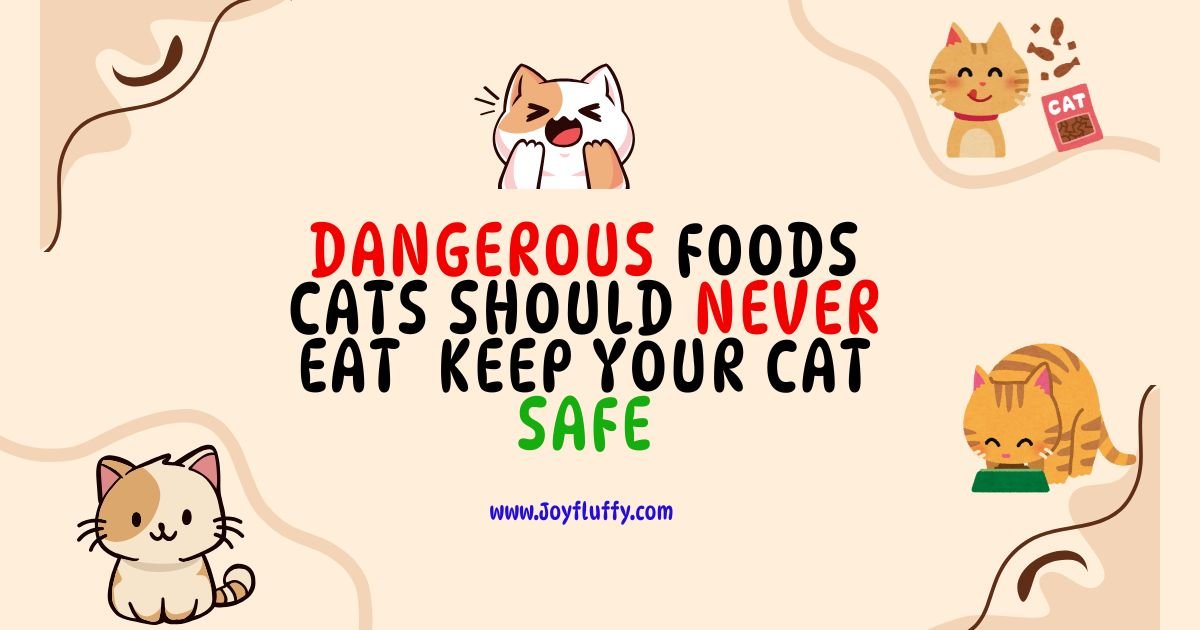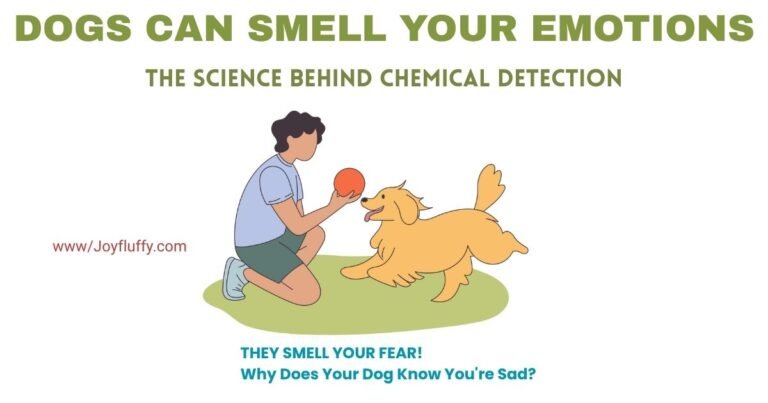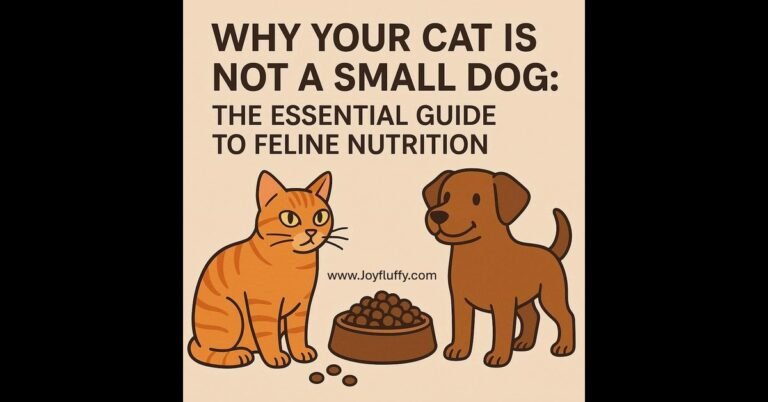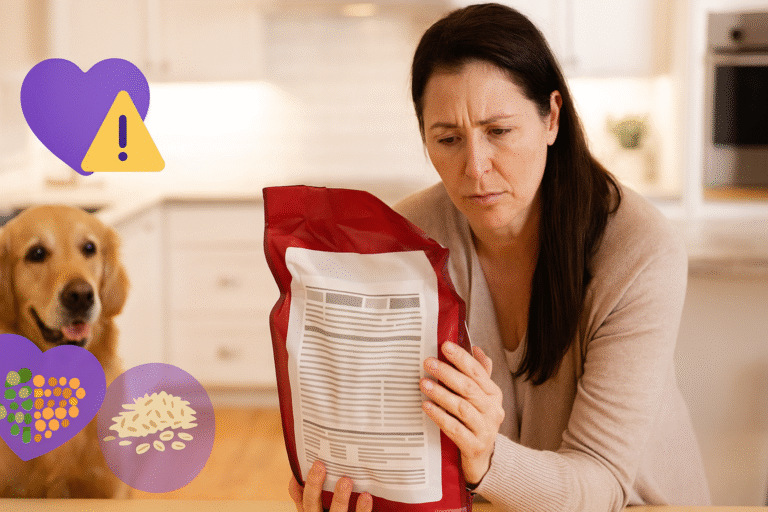21 Dangerous Foods Cats Should Never Eat (Vet-Approved Guide)
🚨 Dangerous Foods Cats Should Never Eat
Protect your feline friend by knowing which common foods are toxic to cats
Cats have unique metabolisms that differ significantly from humans and even dogs. Their bodies process certain substances differently, making foods that seem harmless to us potentially life-threatening to them. Understanding these dangerous foods for cats is essential for every cat owner, whether you’re a first-time pet parent or have lived with cats for years.
Many people are surprised to learn just how many everyday foods can harm their cats. From popular vegetables like onions and garlic to beloved treats like chocolate, the list of dangerous foods cats should never eat is longer than most people realize. In this article, we will explore the most common toxic foods, explain why they are harmful, identify the symptoms of poisoning, and provide practical tips to keep your cat safe.
Why Certain Foods Are Toxic to Cats
Before diving into specific dangerous foods, it is important to understand why cats react differently to certain substances. Cats are obligate carnivores, meaning their bodies are designed primarily to digest and process meat. Unlike humans and dogs, cats lack certain enzymes needed to break down various plant compounds and other substances.
Additionally, cats have a much smaller body mass than humans, which means even tiny amounts of toxic substances can have severe effects. Their liver and kidneys work differently from ours, and they cannot efficiently metabolize certain compounds that would be harmless to us. This is why foods that humans eat regularly without any issues can cause serious health problems in cats.
Another factor is that cats are more sensitive to certain chemical compounds found in foods. For example, thiosulfates in onions and garlic, theobromine in chocolate, and various alkaloids in other foods can cause anything from mild digestive upset to complete organ failure in cats. Understanding this biological difference is crucial for keeping your cat safe from dangerous foods.
The Most Dangerous Foods Cats Should Never Eat
Chocolate
Chocolate tops the list of dangerous foods cats should never eat. This beloved human treat contains theobromine and caffeine, two compounds that are highly toxic to cats. While cats are less likely than dogs to eat chocolate due to their inability to taste sweetness, accidental ingestion can still occur.
Theobromine is particularly dangerous because cats metabolize it extremely slowly. Even small amounts can remain in their system for extended periods, causing severe health issues. Dark chocolate and baking chocolate contain higher concentrations of theobromine than milk chocolate, making them especially dangerous. However, all types of chocolate should be kept completely away from cats.
Symptoms of Chocolate Poisoning in Cats:
- Rapid heart rate and irregular heartbeat
- Restlessness and hyperactivity
- Vomiting and diarrhea
- Increased thirst and urination
- Tremors and muscle twitching
- Seizures in severe cases
- Elevated body temperature
- Difficulty breathing
The severity of chocolate poisoning depends on the type of chocolate consumed, the amount eaten, and the size of your cat. Even a small piece of dark chocolate can be dangerous for a cat. If you suspect your cat has eaten chocolate, contact your veterinarian immediately, even if symptoms have not yet appeared.
Onions and Garlic
Onions, garlic, leeks, shallots, and chives belong to the Allium family and are among the most dangerous foods cats should never eat. These vegetables contain compounds called thiosulfates that damage red blood cells in cats, leading to a condition called hemolytic anemia.
What makes onions and garlic particularly dangerous is that they are toxic in all forms including raw, cooked, powdered, and dehydrated. This means onion powder in baby food, garlic salt, or cooked onions in leftover meals are all equally harmful to cats. Even small amounts consumed regularly over time can lead to toxicity.
The damage to red blood cells is cumulative, meaning that even if your cat does not show immediate symptoms, repeated exposure can cause serious health problems. Some cats may not show signs of poisoning for several days after consumption, making it difficult to identify the source of illness.
Symptoms of Onion and Garlic Toxicity:
- Lethargy and weakness
- Reduced appetite or complete loss of interest in food
- Pale or yellow gums
- Orange to dark red colored urine
- Rapid breathing or panting
- Vomiting and diarrhea
- Increased heart rate
- Collapse in severe cases
It is worth noting that garlic is approximately five times more potent than onions in terms of toxicity. Even garlic supplements that some people give to pets thinking they will help with flea control can be extremely dangerous. Never give your cat any food containing these ingredients, and always check ingredient labels carefully.
Grapes and Raisins
Grapes and raisins are well-known for being toxic to dogs, but they are also dangerous foods cats should never eat. While cats are less likely to consume these fruits voluntarily, accidental ingestion can lead to acute kidney failure, which can be fatal.
The exact toxic compound in grapes and raisins has not been identified yet, and the amount needed to cause toxicity varies between individual animals. Some cats may experience severe reactions from just a few grapes, while others might consume more without obvious symptoms. However, because of the unpredictability and severity of potential poisoning, no amount should be considered safe.
Signs of Grape or Raisin Poisoning:
- Vomiting within the first few hours
- Diarrhea
- Loss of appetite
- Abdominal pain and tenderness
- Decreased urination or no urination
- Weakness and lethargy
- Bad breath
- Tremors or seizures in advanced cases
Kidney failure from grape or raisin toxicity can develop within 24 to 72 hours of ingestion. Early veterinary intervention is critical for the best chance of recovery. If your cat has eaten grapes or raisins, seek emergency veterinary care immediately, even before symptoms appear.
Xylitol (Artificial Sweetener)
Xylitol is an artificial sweetener found in many sugar-free products including gum, candy, baked goods, toothpaste, and some peanut butter brands. While the toxic effects of xylitol are more extensively documented in dogs, it is also considered one of the dangerous foods cats should never eat.
In cats, xylitol can cause a rapid release of insulin, leading to a dangerous drop in blood sugar levels called hypoglycemia. It can also cause liver damage in some cases. Given the increasing use of xylitol in various products, cat owners need to be vigilant about checking ingredient labels.
Products containing xylitol should be stored securely out of your cat’s reach. Even small amounts can be harmful, and the sweetener is being added to an ever-growing list of products, including some unexpected items like vitamins, medications, and even nasal sprays.
Symptoms of Xylitol Poisoning:
- Weakness and lethargy
- Vomiting
- Difficulty walking or standing
- Tremors
- Seizures
- Collapse or loss of consciousness
- Jaundice with liver damage
Alcohol
Alcohol in any form is extremely dangerous for cats. Even small amounts of beer, wine, liquor, or foods containing alcohol can cause serious intoxication in cats. Their small body size means that what might be a minor amount for a human can be life-threatening for a cat.
Cats can be exposed to alcohol not just through drinks but also through fermented foods, unbaked bread dough containing yeast, and even some cleaning products or hand sanitizers. Alcohol is absorbed rapidly into the bloodstream and affects the central nervous system.
Signs of Alcohol Poisoning in Cats:
- Disorientation and confusion
- Vomiting and diarrhea
- Difficulty breathing
- Tremors
- Decreased body temperature
- Slow heart rate
- Seizures
- Coma or death in severe cases
Never give your cat alcohol as a joke or let them lick up spilled drinks. If you suspect alcohol ingestion, seek immediate veterinary care as this is a medical emergency requiring urgent treatment.
Caffeine
Caffeine is found in coffee, tea, energy drinks, soda, and even some medications. Like chocolate, caffeine contains methylxanthines which are toxic to cats. Cats are far more sensitive to caffeine than humans, and there is no safe amount for them to consume.
Coffee grounds, tea bags, and caffeine pills are particularly dangerous if a curious cat gets into them. Even licking up a small spill of coffee or tea can be harmful. The effects of caffeine poisoning are similar to chocolate toxicity because both contain related compounds.
Caffeine Toxicity Symptoms:
- Restlessness and hyperactivity
- Rapid breathing
- Heart palpitations
- Muscle tremors
- Vomiting
- Elevated body temperature
- Seizures
- Collapse
Keep all caffeinated products securely stored and clean up spills immediately. Be especially careful with used coffee grounds and tea bags, as cats may be attracted to the smell and ingest them accidentally.
Raw Eggs, Raw Meat, and Raw Fish
While cats are carnivores and their wild ancestors ate raw meat, domestic cats face risks from consuming raw animal products. Raw eggs contain an enzyme called avidin that interferes with the absorption of biotin, a B vitamin important for skin and coat health. Additionally, raw eggs may contain Salmonella or E. coli bacteria.
Raw meat and fish also carry the risk of bacterial contamination and parasites. Raw fish contains an enzyme called thiaminase that destroys thiamine, an essential B vitamin for cats. Thiamine deficiency can lead to serious neurological problems and can be fatal if left untreated.
Some types of raw fish, particularly tuna, can also contain high levels of mercury. Regular consumption of raw fish can lead to mercury poisoning over time. While many cats love fish, it should only be offered cooked and in moderation as part of a balanced diet.
Signs of Thiamine Deficiency from Raw Fish:
- Loss of appetite
- Seizures
- Abnormal posture with head bent downward
- Loss of coordination
- Dilated pupils
- Circling
- Coma in severe cases
Dairy Products and Milk
Despite the popular image of cats lapping up bowls of milk, most adult cats are lactose intolerant. Kittens produce an enzyme called lactase that helps them digest their mother’s milk, but production of this enzyme decreases as they mature. Without sufficient lactase, cats cannot properly digest the lactose in cow’s milk and other dairy products.
While dairy products are not as immediately toxic as some other dangerous foods cats should never eat, they can cause significant digestive distress. Some cats are more tolerant than others, but it is generally best to avoid giving dairy to your cat altogether.
Symptoms of Lactose Intolerance:
- Diarrhea
- Vomiting
- Abdominal pain and bloating
- Gas
- Loss of appetite
- Dehydration from severe diarrhea
If you want to give your cat a milk-like treat, there are lactose-free cat milk products available at pet stores that are specifically formulated for feline consumption. However, even these should be given in moderation as treats rather than regular dietary staples.
Bones and Fat Trimmings
While it might seem natural to give your cat bones or fat trimmings from your meal, these can be dangerous. Cooked bones can splinter and cause choking, intestinal blockages, or tears in the digestive tract. Even small bones from chicken or fish can pose serious risks.
Fat trimmings, whether cooked or raw, can cause pancreatitis in cats. This is a painful inflammation of the pancreas that can lead to serious complications. High-fat foods can also contribute to obesity and other health problems in cats.
If your cat does ingest a bone, watch carefully for signs of distress. Intestinal blockages and perforations are medical emergencies that require immediate veterinary attention. Never give your cat cooked bones of any kind.
Avocado
Avocados contain a substance called persin, which is toxic to many animals including cats. While the flesh of the avocado contains less persin than the pit, skin, and leaves, all parts of the avocado should be kept away from cats. Even small amounts can cause digestive upset.
Symptoms of Avocado Toxicity:
- Vomiting
- Diarrhea
- Difficulty breathing in severe cases
- Abdominal discomfort
- Fluid accumulation around the heart
Macadamia Nuts
Macadamia nuts are highly toxic to cats and dogs. The exact mechanism of toxicity is not fully understood, but even small amounts can cause serious symptoms. These nuts are often found in cookies, candies, and baked goods, making accidental ingestion a real possibility.
Signs of Macadamia Nut Poisoning:
- Weakness, especially in hind legs
- Vomiting
- Tremors
- Elevated body temperature
- Depression
- Difficulty walking
Other Foods That Are Harmful to Cats
Beyond the most dangerous foods listed above, there are many other items that should be kept away from cats. While some may not be immediately life-threatening, they can still cause health problems and should be avoided.
Citrus Fruits
Lemons, limes, oranges, and grapefruits contain citric acid and essential oils that can cause digestive upset in cats. The stems, leaves, peels, and seeds are particularly problematic.
Raw Dough
Unbaked bread dough containing yeast can expand in a cat’s stomach, causing bloating and pain. The yeast also produces alcohol as it ferments, leading to alcohol poisoning.
Salty Foods
Excessive salt can lead to sodium ion poisoning in cats. Symptoms include vomiting, diarrhea, tremors, elevated body temperature, and seizures. Avoid giving cats salty snacks like chips or pretzels.
Coconut and Coconut Oil
While small amounts may not be toxic, coconut and coconut products can cause stomach upset and diarrhea in cats. The high fat content can also lead to pancreatitis with regular consumption.
Cherries
Cherry pits, stems, and leaves contain cyanide compounds that are toxic to cats. Even the flesh should be avoided as it can cause digestive upset.
Mushrooms
Wild mushrooms can be extremely toxic to cats, and even store-bought varieties can cause stomach upset. It is best to keep all mushrooms away from cats.
Understanding the Relationship Between Cat Behavior and Food Safety
One important aspect of keeping your cat safe from dangerous foods is understanding feline behavior. Cats are naturally curious creatures, and they may investigate new foods or try to access areas where food is stored. Some cats are more food-motivated than others and may actively seek out human food.
Interestingly, cats sometimes exhibit behaviors that might seem like they are ignoring you or being aloof, but they are actually very aware of their environment and what is happening around them. Understanding your cat’s personality and behavior patterns can help you better protect them from accidentally consuming dangerous foods. If your cat seems to be ignoring you or acting differently, it might be worth exploring the reasons behind this behavior. You can learn more about why your cat ignores you and find solutions to better understand your feline companion.
Additionally, it is crucial to remember that cats should never be given sweets or sugary treats. Not only can sugar contribute to obesity and dental problems, but many sweet foods contain dangerous ingredients like chocolate or xylitol. For more detailed information about why sugary foods are harmful to cats, check out this article on why you shouldn’t feed sweets to cats.
What to Do If Your Cat Eats Something Toxic
⚠️ Emergency Response Steps
Time is critical when dealing with potential poisoning. Follow these steps immediately:
Immediate Actions to Take:
- Stay Calm: While it is frightening when your cat eats something dangerous, staying calm helps you think clearly and act efficiently.
- Identify What Was Consumed: Try to determine exactly what your cat ate, how much, and when. This information is crucial for veterinary treatment.
- Contact Your Veterinarian Immediately: Do not wait for symptoms to appear. Call your regular vet or an emergency animal hospital right away. Describe what happened and follow their instructions.
- Call Poison Control: You can contact the ASPCA Animal Poison Control Center at 888-426-4435 or the Pet Poison Helpline at 855-764-7661. These services are available 24 hours and can provide immediate guidance. Note that consultation fees may apply.
- Do Not Induce Vomiting Unless Instructed: While it might seem logical to make your cat vomit, this can sometimes cause more harm depending on what was ingested. Only induce vomiting if specifically instructed by a veterinarian.
- Gather Information: If possible, bring the packaging or a sample of what your cat ate to the veterinary clinic. This helps them determine the best treatment approach.
- Monitor Your Cat Closely: While waiting for veterinary care, watch your cat for any changes in behavior, breathing, or consciousness level. Note any symptoms that develop.
- Transport Safely: When taking your cat to the vet, use a secure carrier. If your cat is having seizures or is unconscious, handle them gently and keep their airway clear.
What NOT to Do in a Poisoning Emergency
There are several common mistakes people make when dealing with potential pet poisoning. Avoid these actions unless specifically instructed by a veterinarian:
- Do not give milk: Contrary to popular belief, milk does not neutralize poisons and can actually make some toxicities worse.
- Do not use home remedies: Activated charcoal, hydrogen peroxide, or other substances should only be used under veterinary guidance.
- Do not wait and see: Even if your cat seems fine, some poisons have delayed effects. Always contact a veterinarian immediately.
- Do not punish your cat: Accidental ingestion is not your cat’s fault. Focus on getting medical help rather than assigning blame.
- Do not delay seeking help: The sooner treatment begins, the better the chances of a full recovery.
Preventing Accidental Poisoning: Practical Safety Tips
🛡️ Create a Cat-Safe Home Environment
Prevention is always better than treatment when it comes to protecting your cat from dangerous foods. Implementing these safety measures can significantly reduce the risk of accidental poisoning.
Kitchen Safety Measures:
- Secure Food Storage: Keep all human food in closed cabinets or containers that your cat cannot access. Use child-proof locks if necessary, especially for lower cabinets.
- Clean Up Immediately: Wipe up spills right away and do not leave food unattended on counters or tables. Cats are excellent jumpers and can easily access food left out.
- Manage Trash Properly: Use trash cans with secure lids. Many toxic foods end up in the garbage, and curious cats may try to investigate.
- Educate Family Members: Make sure everyone in your household, including children and visitors, understands which foods are dangerous for cats and knows not to feed the cat table scraps.
- Be Careful During Holidays: Holiday celebrations often involve chocolate, baked goods with xylitol, and other dangerous foods. Be extra vigilant during these times and keep treats out of reach.
- Check Ingredient Lists: Before giving your cat any human food, even as a small treat, check all ingredients carefully. Many processed foods contain onion or garlic powder.
- Store Groceries Safely: After shopping, put groceries away immediately rather than leaving bags on the floor where cats might investigate.
- Supervise Meal Preparation: Keep cats out of the kitchen during cooking, when dangerous foods are more likely to be accessible.
- Dispose of Dangerous Items Properly: Coffee grounds, tea bags, and other potentially toxic items should be disposed of in secure trash receptacles immediately.
Teaching Children About Pet Safety
If you have children in your home, teaching them about dangerous foods for cats is essential. Children often want to share their snacks with pets, not realizing the harm they could cause. Here are some tips for educating children:
- Explain in age-appropriate language that cats have different bodies than humans and cannot eat the same foods.
- Create a simple list of safe and unsafe foods and post it where children can see it.
- Teach children to always ask an adult before giving the cat anything to eat.
- Involve children in proper cat feeding routines so they understand what is appropriate.
- Praise children when they follow the rules and help keep the cat safe.
Recognizing and Responding to Poisoning Symptoms
Even with the best precautions, accidents can happen. Knowing how to recognize the signs of poisoning in cats can save your pet’s life. Different toxins cause different symptoms, but there are some general warning signs that should always prompt immediate veterinary attention.
Digestive Symptoms
Vomiting, diarrhea, drooling, loss of appetite, and abdominal pain are common early signs of poisoning. Blood in vomit or stool is especially concerning.
Neurological Symptoms
Tremors, seizures, disorientation, difficulty walking, weakness, or changes in consciousness require immediate emergency care.
Cardiovascular Symptoms
Rapid or slow heart rate, irregular heartbeat, pale or blue gums, and difficulty breathing indicate serious poisoning.
Behavioral Changes
Unusual lethargy, hyperactivity, hiding, aggression, or any sudden change in normal behavior can signal toxicity.
It is important to note that symptoms may not appear immediately after ingestion. Some toxins take hours or even days to cause noticeable effects. This is why contacting a veterinarian immediately after known exposure is crucial, even if your cat seems perfectly fine.
Safe Treat Alternatives for Your Cat
Now that we have covered all the dangerous foods cats should never eat, you might be wondering what you can safely give your cat as a treat. While commercial cat treats are the safest option, there are some human foods that are safe for cats in small amounts:
Safe Human Foods for Cats (in Moderation):
- Cooked Plain Chicken or Turkey: Small pieces of unseasoned, cooked poultry without bones are safe and nutritious.
- Cooked Fish: Plain cooked salmon or tuna in small amounts can be a nice treat. Avoid seasoning and do not make fish a regular part of the diet.
- Cooked Eggs: Plain scrambled or hard-boiled eggs provide good protein. Ensure they are fully cooked.
- Small Pieces of Cooked Vegetables: Some cats enjoy tiny amounts of cooked carrots, green beans, or peas. These should be plain and unseasoned.
- Plain Pumpkin: A small amount of plain canned pumpkin (not pumpkin pie filling) can help with digestion.
- Cantaloupe or Watermelon: Some cats enjoy small pieces of these melons as an occasional treat. Remove all seeds.
- Cooked Rice: Plain cooked rice in small amounts is generally safe and can help settle an upset stomach.
Remember that treats should make up no more than 10 percent of your cat’s daily caloric intake. The majority of their nutrition should come from complete and balanced commercial cat food formulated to meet their specific dietary needs.
Always introduce new foods gradually and in very small amounts to watch for any adverse reactions. Even safe foods can cause digestive upset if given in large quantities or to cats with sensitive stomachs.
The Importance of Regular Veterinary Care
Maintaining regular veterinary check-ups is an important part of keeping your cat healthy and safe. Your veterinarian can provide personalized advice about your cat’s diet and help you understand any specific sensitivities or health conditions that might affect what foods your cat can safely consume.
During routine visits, discuss any dietary questions or concerns you have. Your vet can recommend appropriate commercial cat foods, suggest safe treat options, and provide guidance on portion sizes appropriate for your cat’s age, weight, and activity level.
Additionally, keeping your veterinarian’s contact information easily accessible, along with the phone numbers for emergency veterinary services and poison control hotlines, ensures you can act quickly if an emergency occurs.
Understanding Product Labels and Hidden Dangers
Many dangerous foods for cats hide in processed products where you might not expect them. Learning to read ingredient labels carefully is an important skill for cat owners. Here are some things to watch for:
- Onion and Garlic Powder: These appear in many seasoned foods, baby foods, broths, and gravies.
- Xylitol: Check sugar-free products including gum, candy, baked goods, peanut butter, and even some medications.
- Cocoa or Chocolate: Obviously in desserts, but also in some protein powders and nutritional supplements.
- Caffeine: In coffee-flavored items, some sodas, energy drinks, and diet pills.
- Artificial Sweeteners: Various artificial sweeteners beyond xylitol may also be harmful.
When in doubt about any ingredient, look it up or contact your veterinarian before giving that food to your cat. According to the ASPCA Animal Poison Control Center, thousands of cats experience poisoning incidents each year, many from common household foods.
Special Considerations for Multi-Pet Households
If you have both cats and dogs in your home, food safety becomes even more complex. Dogs can safely eat some foods that are toxic to cats, and vice versa. This means you need to be extra careful about where and how you feed your pets.
Consider feeding cats and dogs in separate areas to prevent cats from accessing dog food or treats that might contain harmful ingredients. Dog treats sometimes contain garlic or onion powder for flavor, which is dangerous for cats. Similarly, some cat foods are too rich for dogs and can cause digestive upset.
Store pet foods and treats separately and clearly labeled to avoid confusion. Make sure all family members understand which products are for which pets.
Long-Term Health Implications
Beyond immediate poisoning risks, regularly feeding cats inappropriate foods can lead to long-term health problems. Obesity, diabetes, kidney disease, and other chronic conditions can develop from poor dietary habits.
Cats fed a diet high in human foods may become finicky eaters and refuse their nutritionally complete cat food. This can lead to nutritional deficiencies over time. Additionally, the digestive upset from inappropriate foods can damage the gastrointestinal system and lead to chronic issues like inflammatory bowel disease.
Maintaining a consistent, appropriate diet is one of the best ways to ensure your cat lives a long, healthy life. While the occasional small treat of safe human food is unlikely to cause problems, making it a regular habit can have serious consequences.
Resources for Cat Owners
Staying informed about cat nutrition and safety is an ongoing process. Here are some reliable resources for cat owners:
- ASPCA Animal Poison Control Center: 888-426-4435 (fees may apply)
- Pet Poison Helpline: 855-764-7661 (fees may apply)
- FDA Pet Food Safety: Provides information about pet food recalls and safety alerts
- Your Veterinarian: Always your best resource for personalized advice
The FDA Center for Veterinary Medicine provides excellent information about pet food safety and nutrition that can help you make informed decisions about what to feed your cat.
Final Thoughts: Keeping Your Cat Safe and Healthy
Understanding which dangerous foods cats should never eat is a fundamental responsibility of cat ownership. From chocolate and onions to grapes and xylitol, many common household foods pose serious risks to our feline friends. The key to prevention lies in education, vigilance, and creating a safe home environment.
Remember that cats depend entirely on us to make safe choices for them. They cannot understand which foods are dangerous, and their natural curiosity can lead them into harmful situations. By keeping dangerous foods securely stored, educating family members, and knowing how to respond in an emergency, you can significantly reduce the risk of poisoning.
If you ever have doubts about whether a food is safe for your cat, the safest choice is to avoid giving it altogether and consult your veterinarian. When it comes to your cat’s health and safety, it is always better to be overly cautious than to take unnecessary risks.
Your cat’s well-being is worth the extra effort it takes to keep dangerous foods out of reach and to provide a nutritionally appropriate diet designed specifically for feline needs. With proper care, attention, and knowledge, you can help ensure your beloved cat lives a long, healthy, and happy life free from the dangers of toxic food exposure.
Quick Reference: Emergency Contact Information
Save these numbers in your phone now:
- Your Regular Veterinarian: ________________
- Emergency Veterinary Clinic: ________________
- ASPCA Poison Control: 888-426-4435
- Pet Poison Helpline: 855-764-7661
Post this information on your refrigerator and share it with pet sitters or anyone who cares for your cat.




